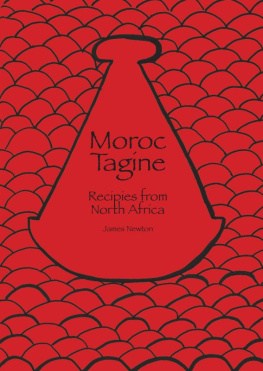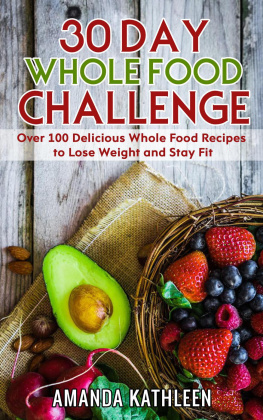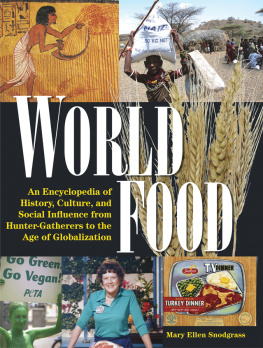The World Cookbook
The Greatest Recipes from around the Globe, Revised Edition Jeanne Jacob Michael Ashkenazi

Copyright 2014 ABC-CLIO, LLC All rights reserved. No part of this publication may be reproduced, stored in a retrieval system, or transmitted, in any form or by any means, electronic, mechanical, photocopying, recording, or otherwise, except for the inclusion of brief quotations in a review, without prior permission in writing from the publisher. The publisher has done its best to make sure the instructions and/or recipes in this book are correct. However, users should apply judgment and experience when preparing recipes, especially parents and teachers working with young people. The publisher accepts no responsibility for the outcome of any recipe included in this volume and assumes no liability for, and is released by readers from, any injury or damage resulting from the strict adherence to, or deviation from, the directions and/or recipes herein. The publisher is not responsible for any readers specific health or allergy needs that may require medical supervision, nor for any adverse reactions to the recipes contained in this book.
All yields are approximations. Library of Congress Cataloging-in-Publication Data Jacob, Jeanne. [World cookbook for students] The world cookbook : the greatest recipes from around the globe / Jeanne Jacob and Michael Ashkenazi. Revised edition. volumes cm ISBN 978-1-61069-468-1 (hardback : acid-free paper) ISBN 978-1-61069-469-8 (ebook) 1. 2. 2.
Food habits. I. Ashkenazi, Michael. II. Jacob, Jeanne. III. Title. Title.
TX725.A1J23 2014 641.59dc23 2013024026 ISBN: 978-1-61069-468-1 EISBN: 978-1-61069-469-8 18 17 16 15 14 1 2 3 4 5 This book is also available on the World Wide Web as an eBook. Visit www.abc-clio.com for details. Greenwood An Imprint of ABC-CLIO, LLC ABC-CLIO, LLC 130 Cremona Drive, P.O. Box 1911 Santa Barbara, California 93116-1911 This book is printed on acid-free paper  Manufactured in the United States of America Illustrations by Jeanne Jacob and Maayan Ashkenazi THE WORLD COOKBOOK THE WORLD COOKBOOK THE GREATEST RECIPES FROM AROUND THE GLOBE, REVISED EDITION Volume 14 AZ Jeanne Jacob and Michael Ashkenazi GREENWOOD AN IMPRINT OF ABC-CLIO, LLC Santa Barbara, California Colorado Oxford, England To Violeta Jacob Bulao, for her creativity in the kitchen and for teaching Jeanne how to cook and to be curious about exotic food and to the memory of Shunz Okuyama and Gilli Asseo (March 195321 July 2013), companions along our culinary odyssey.
Manufactured in the United States of America Illustrations by Jeanne Jacob and Maayan Ashkenazi THE WORLD COOKBOOK THE WORLD COOKBOOK THE GREATEST RECIPES FROM AROUND THE GLOBE, REVISED EDITION Volume 14 AZ Jeanne Jacob and Michael Ashkenazi GREENWOOD AN IMPRINT OF ABC-CLIO, LLC Santa Barbara, California Colorado Oxford, England To Violeta Jacob Bulao, for her creativity in the kitchen and for teaching Jeanne how to cook and to be curious about exotic food and to the memory of Shunz Okuyama and Gilli Asseo (March 195321 July 2013), companions along our culinary odyssey.
Contents
List of Countries and Regions
List of Recipes by Region
AFRICA
ASIA
THE CARIBBEAN AND NORTH AMERICA
EUROPE
THE MIDDLE EAST
OCEANIA
SOUTH AMERICA
List of Sidebars by Country
Preface
The objective of this book is to introduce readers, in particular U.S. students, to contemporary foodstuffs, ways of eating, and typical cookery in every country in the world.
With a few exceptions, we have tried to provide some insight into all nation-states (and some nationalities without states) existing today: 205 in all, including newly independent Kosovo and South Sudan. A brief introduction of each countrys history, geographic conditions, and ethnic and/or religious composition provides a rationale for the types of foodstuffs eaten and the ways of preparing and eating those items. Approximately eight (in some cases more) recipes are provided per country or group, totaling over sixteen hundred. There are over four hundred new recipes in this revised edition of the work. The reader whose interest is piqued by one or another of the cuisines introduced here is urged to access other resources, some of which are noted in the bibliography, to deepen and widen this initial acquaintanceship. Another objective is to allow a certain degree of comparison between different food cultures.
Several variants are offered of some common dishesfor example, flavored/fried rice, stuffed vegetables, pasta, filled dumplings, and baklava pastrythat can be found in more than one culture. This will allow you to see how the same dish has been modified to suit different conditions. Readers with an additional interest in languages and history will be able to see the commonality of certain dishes such as filled dumplings in Mongolia, Central Asia, and Eastern Europe. We have deliberately left out some of the more prominent and well-known national dishes in favor of less-well-known (in the United States, at least) dishes that are nonetheless popular in their countries of origin. We were also advised to avoid recipes that (a) require special ingredients unavailable in the United States, (b) may not be suited to American taste, and (c) are too complicated. Of course, none of these principles can be strictly observed: the entire point of national cuisines is that they make use of local resources, and many of these are not, or cannot be, exported.
Wherever possible, however, we have made suggestions for substitutions. These might offend the purist: they certainly will change the flavor of the dish concerned. However, substitution at least gives you an opportunity to try the cooking method indicated and to taste a shadow of the real thing. Naturally, there are, in most cases, more than a few recipes that fit even our restrictive criteria. When choosing a recipe, we relied primarily on the criteria mentioned, but when faced with a multitude of recipes for the same dish, and even more, when we had to choose between different dishes, all of which would have fit, we adopted a simple scientific principle: whether we ourselves liked the dish in question! And, on occasion, we have indulged ourselves. Rather than choosing the most representative dish in any country, we selected one that we knew and had enjoyed ourselves.
We hope you will enjoy them as well. We have also, where necessary, simplified recipes to make them accessible to the target audience. Because simplification can be at the cost of authenticity, we apologize in advance to purists.
COOKING, PREPARATION, AND RECIPES
Some general principles of food preparation are worth noting, and they apply, on the whole, throughout human cooking. Every human society indulges in some form of cooking. In no society is all food eaten untreated.
Treatment forms are a fairly restricted set. There are only so many ways to apply heat to food or to change its chemical composition. Many societiesbecause of their local ecology, or for historical or technological reasonstend to focus on or use one or another technique extensively. Obviously, the more sophisticated the technology available in a society and the wealthier the society, the more options there are. For example, simpler societies tend to use roasting, boiling, fermenting, treating in acidic liquids, and baking in embers or an earth oven exclusively, whereas technologically sophisticated societies have a range of cooking equipment, from barbecue grills to freezers and microwave ovens. In addition to cooking through the application of heat, there are a number of other ways of modifying foodstuffs to alter their flavor, texture, or preservation qualities.
Marinating in an acidic liquid is a common wayin the form of Osaka-style sushi, ceviche, or cucumber picklesto preserve and change the flavor of food. Salting and smoking, largely used with fish and seafood, are also extensively applied to meat to make sausages, bacon, and ham. Fermentation of fish, legumes, milk, fruits, and grains with fungi not only preserves these foods but also changes them into completely different foodstuffs: fish sauce, soy sauce, tofu, yogurt, cheese, wine, rum, beer, and so on. One or another of these techniques, and often several, are used to provide unique flavors and textures to different foodstuffs throughout the world. One thing to keep in mind is that recipes are not formulae; they are guidelines. With the exception of some forms of cooking, such as baking, where certain chemical processes must take place in a certain order, most dishesincluding the most treasured national dishesare subject to individual interpretation and variation.





 Copyright 2014 ABC-CLIO, LLC All rights reserved. No part of this publication may be reproduced, stored in a retrieval system, or transmitted, in any form or by any means, electronic, mechanical, photocopying, recording, or otherwise, except for the inclusion of brief quotations in a review, without prior permission in writing from the publisher. The publisher has done its best to make sure the instructions and/or recipes in this book are correct. However, users should apply judgment and experience when preparing recipes, especially parents and teachers working with young people. The publisher accepts no responsibility for the outcome of any recipe included in this volume and assumes no liability for, and is released by readers from, any injury or damage resulting from the strict adherence to, or deviation from, the directions and/or recipes herein. The publisher is not responsible for any readers specific health or allergy needs that may require medical supervision, nor for any adverse reactions to the recipes contained in this book.
Copyright 2014 ABC-CLIO, LLC All rights reserved. No part of this publication may be reproduced, stored in a retrieval system, or transmitted, in any form or by any means, electronic, mechanical, photocopying, recording, or otherwise, except for the inclusion of brief quotations in a review, without prior permission in writing from the publisher. The publisher has done its best to make sure the instructions and/or recipes in this book are correct. However, users should apply judgment and experience when preparing recipes, especially parents and teachers working with young people. The publisher accepts no responsibility for the outcome of any recipe included in this volume and assumes no liability for, and is released by readers from, any injury or damage resulting from the strict adherence to, or deviation from, the directions and/or recipes herein. The publisher is not responsible for any readers specific health or allergy needs that may require medical supervision, nor for any adverse reactions to the recipes contained in this book.  Manufactured in the United States of America Illustrations by Jeanne Jacob and Maayan Ashkenazi THE WORLD COOKBOOK THE WORLD COOKBOOK THE GREATEST RECIPES FROM AROUND THE GLOBE, REVISED EDITION Volume 14 AZ Jeanne Jacob and Michael Ashkenazi GREENWOOD AN IMPRINT OF ABC-CLIO, LLC Santa Barbara, California Colorado Oxford, England To Violeta Jacob Bulao, for her creativity in the kitchen and for teaching Jeanne how to cook and to be curious about exotic food and to the memory of Shunz Okuyama and Gilli Asseo (March 195321 July 2013), companions along our culinary odyssey.
Manufactured in the United States of America Illustrations by Jeanne Jacob and Maayan Ashkenazi THE WORLD COOKBOOK THE WORLD COOKBOOK THE GREATEST RECIPES FROM AROUND THE GLOBE, REVISED EDITION Volume 14 AZ Jeanne Jacob and Michael Ashkenazi GREENWOOD AN IMPRINT OF ABC-CLIO, LLC Santa Barbara, California Colorado Oxford, England To Violeta Jacob Bulao, for her creativity in the kitchen and for teaching Jeanne how to cook and to be curious about exotic food and to the memory of Shunz Okuyama and Gilli Asseo (March 195321 July 2013), companions along our culinary odyssey.